Text
Armando Poeta’s Flying Essentials: Learn What Being a Pilot Means
Becoming a pilot is something every child dreams of at some point. Armando Poeta had the same dream which he fulfilled first by serving in the Italian Airforce and then working as a flight instructor and commercial pilot.

From his experience, Armando Poeta shares that being a good pilot requires a mix of technical and interpersonal skills. They need to be quick, and agile, have the ability to manage teams, and much more. Psychologically, pilots should ideally have spatial intelligence—the ability to perceive patterns and visual data. This article lists some other skills a person needs to become a pilot according to Armando Poeta.
An understanding of physics and math
The application of many concepts of maths and physics is required in the aviation process, from mass and balance to different calculations. Being comfortable with these subjects will help you both in the training school and actually flying independently.
Understanding aircraft systems
As a pilot, you should know your aircraft inside out, says Armando Poeta. Pilots are required to perform checks on every part of the airplane before taking off to ensure everything is in order. This is also something you will be trained for, and will be one of the most essential things you learn. So pay attention!
Attention to detail
As mentioned, you will have to deal with checklists, calculations, and coordinates, and have to adapt to weather or technicalities. All this requires acute attention to detail and being aware of your surroundings at all times.
Communication and teamwork
A pilot is only as good as his crew. You will have to work in close tandem with the co-pilot and crew while flying, so learning how to manage and work in a team becomes important. At the same time, you will also be following the guidance from the control towers, and knowing how to communicate and understand critical information briskly is paramount.
Quick thinking and decision making
Whether it be dynamic weather or last-minute changes to the flying plan or a technical issue, quick decision-making is a skill every pilot needs. According to Armando Poeta thinking on your feet as you are miles in the air is both a thrill and a huge responsibility. You have to be aware of how your decision affects you but also everyone else on the aircraft.
Ability to manage stress
With this requirement of being aware, adapting to circumstances, and making decisions comes a lot of stress. The pressure is heightened when you hit a snag or are in a dangerous position. Remaining calm and communicating your issues with those on the ground, or being able to coordinate the best course of action with your team is something a good pilot should be able to do in high-stress situations.
According to Armando Poeta, being a pilot is a wonderful adventure every time, but it comes with a lot of responsibilities and stress. Being able to manage that and be alert at all times is needed if you wish to be an excellent pilot. Aviation is full of dynamic factors and a pilot has to balance all of them.
Of course, all pilots—regardless of industry—go through vigorous training before they are qualified to fly independently. These are just a few things you will learn in the course of your training, but they will make the foundation of everything else you learn. If you feel these are skills you already have, then Armando Poeta recommends trying aviation as a career.
0 notes
Text
Armando Poeta Explains Integrated Autonomous Tow System I-ATS
Today, technology is changing everything for the better. Efforts are underway in all industries to use technology to reduce costs, increase efficiency, and build more sustainable alternatives to how things are presently done.
In the aviation business, there is a current need for a more efficient way of towing and/or taxing a plane to and from a runway. Modern aircraft have up to four engines that are all used to reach the runway from the terminal. In places as busy as Los Angeles International LAX, it however takes more than an hour till the plane is actually authorized to take off. The fuel used up in that time costs a lot of money than could be more useful elsewhere, not to mention the environmental consequences of this excess.

The whole process of taxiing and choosing the terminals from which a plane departs is a complex and time taking process managed by the airport controllers. A solution to the current problems of taxing, according to Armando Poeta would be developing and using an electric tow to move the aircraft to and from the runway without any engines(or fuel) until they are needed for takeoff. Armando Poeta envisions this device connecting to the plane at the gate, which would be operated by the ground crew for the push-back maneuvers in the close and congested area of the terminal. Currently, when the ground crew disconnects from the tow, the pilots start the engines and start to taxi. This can happen on a single engine but, sometimes up to four engines can be started to taxi.
An alternative would be a new I- ATS being activated at this point of taxiing. This could be either operated by the pilot using aircraft flight controls, giving them the control to stop for checks as needed, or it could be operated by a ground controller. Once the pilot or controller decides that the plane is at the point where the pilot needs to start the engines in preparation for takeoff, the system will be disconnected. It can be then routed to a dedicated place at the airport where it can recharge while waiting for the next plane to tow.
Similarly, this system can also be used to tow the aircraft back to the gate after landing—maneuvers that can take just as long as the taxi out for takeoff considering the current and future congestion of busy airports around the world.
In the future, Armando Poeta imagines the development of a system that will be completely autonomous. The system would be able to take the plane to its destination with no intervention from humans.

Armando Poeta suggests such systems be completely electric to reduce or replace both the use of fuel and the emissions from engines, until necessary. This system would be completely integrated into the airport system with the controller and pilots operating it and giving inputs to determine its best use and destination.
As the world population continues to grow, Armando Poeta believes such autonomous systems which reduce human effort and are better for the environment will become essential in ever more congested airports. Technology and AI are the future, and the aviation industry can benefit from them the most.
0 notes
Text
How Military Experience Can Help You Become an Effective Leader
Every year, over 5000 applications are sent to the Italian Air Force. Only 100 are selected to start training. In August 1994 Armando Poeta was one of them. The military branch is passionate about finding the people that are right for the job.
During three and a half years in the Air Force Academy, hard training begins. Cadets must partake in military drills, pilot training, college study courses, and more. They are not just learning what it takes to be a good soldier. They are learning what it takes to be a good leader.
How Does the Military Help You Become an Effective Leader?
One need only look at the 11 Marine Corps Leadership Principles to understand how they can help an individual become an effective leader in civilian life. They include the following:
Military Principle 1: Know Yourself and Seek Self-improvement
On a Civilian Level: A greater self-awareness will allow you to reach your full potential. It will help you recognize similar traits in others so you can lead them toward goal fulfillment.
Military Principle 2: Be Technically and Tactically Proficient
On a Civilian Level: Know your job so you can guide others.
Military Principle 3: Know your Marines and Look Out for Their Welfare
On a Civilian Level: A leader will look out for their team. They will take a caring approach that promotes loyalty, trust, and productivity.
Military Principle 4: Keep Your Marines Informed
On a Civilian Level: A leader will keep their team abreast of the latest developments. This approach will make employees feel more valued. It will eliminate repetitive actions and boost productivity.
Military Principle 5: Set the Example
On a Civilian Level: Don’t expect your team to display exemplary behavior unless you show it yourself.
Military Principle 6: Ensure the Task is Understood, Supervised, and Accomplished
On a Civilian Level: A good leader will be there for their team from the beginning to the end. They will ensure employees have a solid grasp of the task at hand. They will supervise them to ensure assignments are completed without micromanaging.
Military Principle 7: Train Your Marines as a team
On a Civilian Level: Due to different positions within teams, training may require one on one time with different employees. While this differs from military training, which has a more uniform approach, the idea of training employees as a team carries over. It promotes a sense of unity which is important in leadership.
Military Principle 8: Make Sound and Timely Decisions
On a Civilian Level: A leader must be ready to think on their feet and make smart decisions promptly.
Military Principle 9: Develop a Sense of Responsibility Among Your Subordinates
On a Civilian Level: Although leaders are encouraged to treat their team as equals on many levels, they should promote a sense of responsibility when it comes to meeting deadlines and achieving goals.
Military Principle 10: Employ your Command By its Capabilities
On a Civilian Level: Leaders must be aware of their team member’s capabilities and assign tasks they feel they will excel at.
Military Principle 11: Seek Responsibility and Take Responsibility for Your Actions
On a Civilian Level: Leaders should be accountable for their actions and admit when they are wrong. This will help promote loyalty in the workplace. It will set an example for those around them.
Military vs. Civilian Leadership
Military experience can go far in helping you become an effective leader, Armando Poeta says, but there are key differences to note when comparing it to civilian life. For one, the military style of leadership is more directive, rigid and task-oriented. This is mainly because a danger to life and property is involved which is not typically the case in the private sector.
There’s also less flexibility in the military leadership approach. In civilian life, the background of each individual is considered when determining the tasks they will be assigned and how best to complete them. In the military, all soldiers in a unit are guided with the same approach and must complete the same assignments.
The goal of military and civilian leadership also differs. Civilian leadership focuses on ROI, i.e., how much of a return on investment the company or individual will be seeing from a certain task or process. In the military, different goals such as self-improvement and protecting others come into play.

Armando Poeta thinks that, despite differences in military and civilian leadership, the principles are highly adaptable to one another. A good military leader can easily become a trusted authority in civilian life. The valuable lessons translate to encourage powerful results over a wide range of applications.
0 notes
Text
Enhanced Black Box for Safer Flying by Armando Poeta
Flying has become safer over the years, with the number of accidents and fatalities reducing progressively. Statistics show a variety of reasons for aviation accidents with human errors coming top of the list. The actual causes for the accidents are generally multiple and can only be precisely understood once the parts of the aircraft, especially the black boxes are collected. With his years of experience in the industry, Armando Poeta believes that there is a need for advanced technology to prevent or reduce aircraft accidents, and investigate them when they do occur.
Current Technologies
Currently, modern aircrafts use a device to investigate crash accidents, which is made of two components: the Flight Data Recorder (FDR) and the Cockpit Voice Recorder (CVR) generally known as a black box.

In order to provide data for a crash investigation, the black box must be recovered from the aircraft and analyzed. However, recent accidents have proven the limits of this technology.
Armando Poeta recounts the example of the Malaysia Flight MH 370 involving a Boeing 777 that crashed into the ocean. Despite weeks of search, neither the flight nor the black box was ever recovered—leaving us with no information regarding the cause. Similarly, the more recent China Eastern 737 crash would have benefited from a new technology that can be easily implemented.
Improving for the Future
Armando Poeta believes that the current black box can be upgraded using some current technologies. An enhanced black box that can overcome these limitations should have the following features:
Real-time data transmission
Detachable and floating qualities.
Firstly, the plane would simply transmit data via satellite to a dedicated ground station, regarding basic information such as position, altitude, speed, and rate of climb and descent. Armando Poeta thinks that the black box can further be programmed to release more information, such as the last 30 seconds of the cockpit voice recorder, engine data, throttle setting, flight controls position, aircraft configuration, etc., in a situation of possible threat (for example in the case of a plane exceeding a certain number of Gs or rate of descent).

With that information, investigators will have better tools to identify the possibility of a crash and the location of the plane for either search and rescue or recovery operations. This possibility of transmitting data to a ground station is already available today but is an option that a customer may need to buy. Instead, offering this feature to a dedicated team may help monitor the path of every plane and identify problems as soon as they occur, according to Armando Poeta. It can help the crew deal with an unusual situation before it becomes a major problem.
This feature would have been valuable to get better information sooner in the two crashes mentioned by Armando Poeta above. In the case of MH 370 in particular, the plane might have been located and intercepted after going off route for a long time before it lost contact.
The second feature to enhance a black box according to Armando Poeta would involve ejecting the black box in case of a water crash. In such an event, the black box is usually either lost forever, or may be unusable, like in the event of the Chinese crash. But Armando Poeta believes the black box can be ejected and put on a floating device with an antenna that transmits a signal to a dedicated station. This would help identify the location of the black box and the wreckage of the plane nearby.
Armando Poeta says that implementing these two features together or individually can give airlines company a better tool to analyze the root cause of an accident to avoid it in the future. Companies like Airbus have been working on similar technologies which will be essential in forming the future of safe aviation.
0 notes
Text
Armando Poeta Suggests a Revolutionary Way to Build Commercial Airliners for the Future
The world economy has been hard hit by the pandemic and its consequences. A lot of industries are feeling the burn of recession and struggling to find innovative ways to cut costs while maintaining quality. Armando Poeta observes a need to especially reduce the cost of building, operating, and training both pilots and ground crews on commercial aircraft in the aviation industry.
The Problem
Modern aviation today is composed of planes that are best fit for the specific market target. Let’s think about the difference you can see in the 737, 747, 787, etc.


Armando Poeta notes how all these aircrafts are completely different from each other. The shape of the fuselage, wings, tails, and systems, are all different with minimal interchangeability. These differences lead to increased costs of development, testing, operation training, maintenance, and more. And yet, A common type of plane that can carry from 50 to 350 passengers and can be adapted to most of the jobs performed today.
A Better Way
A first solution is already in use by some of the manufacturers, like Bombardier says Armando Poeta. The CRJ series comes in different sizes with the only difference in the length of the fuselage. The rest of the airplane is essentially still the same design. This partially solves the problem of building one plane for different kinds of payloads. The advantage of this method is that one pilot that is trained on the CRJ 200 can fly the CRJ 900 without any extra training. The same goes for the ERJ 175/195 made by Embraer or the A-319/320/321 made by Airbus. However, this also results in some models with tails and cockpits that are too big or too small.

The Solution
So the need is to reduce building costs and increase the efficiency of planes which provides advantages for both the manufacturers and the customers. The solution Armando Poeta suggests is simple and involves two components: the proper size of the components and the interchangeability of the components.
The first solution is to properly size all the components of the plane and to keep the proportions, to build a plane of the proper size for the target payload. The experience of the 737 MAX has thought us that taking a small plane and making it bigger and bigger may not work. Taking the 737 and stretching it to the current MAX version caused stability problems. But Armando Poeta believes that reversing the procedure can be a better solution—taking a bigger plane and reducing its size. For example, if the current 787 is safe to fly at its current dimensions, it will be also safe to fly if it is shrunk down by keeping the proportion of all the parts.
Armando Poeta explains, the regular 787 can be used for heavy loads. By reducing the cross-section of the fuselage and the dimensions of the wings and tail, and keeping the original proportions between components, we can build a smaller version for a payload equivalent to the current 757 and 767. Reduce it again and we have an airplane that can carry the payload of the current 737. Eventually, reducing it further can lead to an aircraft equivalent to a current regional jet. This small version can also be adapted to corporate jets.





The Advantages
The obvious advantage of this solution is the optimization in the process of the whole development, manufacture, training, operation, and face out of the plane. Moreover, as the 787 in our example is an already existing plane, the certification to a smaller size may not be as time-consuming and as expensive as it would be od a brand-new aircraft built from scratches.
Armando Poeta also thinks, that done right, one pilot or mechanic that is certified to fly or work on one of those planes may be allowed to operate all of them with minimal training leading to saving time and money for every player involved.
The Other Shoe
The second part of the solution is to build aircraft with interchangeable components, to adapt them to different needs. To explain this better, Armando Poeta takes the example of the Boeing 787 and breaks it down into three main components:
The front portion
The central portion
The tail portion
This is how Armando Poeta envisions the interchangeability to work.

Changing one of those three components and replacing the main of the current aircraft in use today.

High wing configuration for turboprop or jet, to replace C-130 and regional turboprop.

Low wing configuration with T-tail to replace C-5, C-17, and similar.

Low wing configuration with the central part retrofit for dropping of the ordinance from fire retardant to bombs — to replace current B-52 and 747 fire tanker.
This solution can not only help the industry cut costs but also be more efficient as we move into a more tech-driven future.
0 notes
Text
Armando Poeta Suggests Voice-Controlled Programming for the Future of Flying
Overview
Advancing technology has led to many developments including in industries like aviation.
Further integrating technology such as voice control programming in autopilot is another step toward the future.
It will help pilots focus better, facilitate communication between pilots and controllers with language differences, and reduce radio traffic.
Possible future implementation of this technology can include other vehicles from spaceships to cars to vessels.
Technology has changed the way we interact, shop, travel, make decisions, and think. Air travel for the masses seemed like a dream not so long ago. Yet today, aviation is a thriving industry that continues to develop, and it seems vacations in space are not such a far-fetched dream.
While modern aircraft are already equipped with the most sophisticated and advanced autopilot in the industry, there is always room for improvement. Armando Poeta, speaking from his experience of 19 years in the Italian Air Force, pointed out that the limit to the autopilot function was that the pilot needs to go “head down” to program it. During high workload environments—something Armando Poeta is quite familiar with—such as when flying below 10,000 ft, changes in the flight plan—for example, receiving a different runway to land, may require both pilots to divert their attention from making sure of no other traffic to look inside and program the autopilot and/or read the charts.
Voice-Controlled Autopilot Programming
According to Armando Poeta, a simple solution would be to implement the existing modern technology which allows us to control our personal devices through voice commands, like Siri, and integrate it with the autopilot and/or flight controls.
The idea of voice-controlled aircrafts is not too foreign and has been considered by many industry leaders. Armado Poeta thinks the idea is gaining popularity because of its simplicity and the ease with which it can be turned into reality.
So how would it actually work? The Voice Control and Command (VCC) software, when activated, would run in the background of the autopilot function in aviation and monitor radio conversation. The software would be programmed to recognize when Air Traffic Control (ATC) contacts a specific airplane and gives her a particular command, such as “Delta 123 climb and maintain FL 230”. With this set and structured command, Armando Poeta believes the system would be able to preprogram the autopilot command and wait for the pilot to verify them and give their consent to execute or not.
Using Technology To Bridge Language Barriers
But what about non-English speaking areas? Armando Poeta recognizes that in places where English is not the first language, it may be difficult for AI to understand what the instruction of the controller may be. The solution could be providing a data function used to type commands to a plane and send it to them via a data link. The system can then interpret this command and use it to program the autopilot. Again, while the system would program according to the command received, it would only be executed after verification by the pilot to minimize error.
The technology can be further integrated to allow the pilot to do the same from the inside of the plane by pushing a specific, dedicated button to activate the system and give commands to the plane without getting too distracted from monitoring external factors. The command could go something along the lines, of Delta 123 load ILS 24L at LAX, XYZ transition. Once the system programs the same, the pilot would activate the controls after verifying.
Safer and Easier Flying
Armando Poeta comments on how this kind of technology can also be very useful to reduce radio chatter for routine conversation that can make a frequency busy and unavailable to an aircraft in actual distress. It could also reduce miscommunication between the pilot and ATC who speak different languages, or where the radio coverage is not optimal.
As someone who has been flying since they were 16, Armando Poeta believes that helping the pilots to look outside and keep their hands on the controls rather than on managing the autopilot and Flight Management System (FMS) makes the job easier and safer for them
Possible future implementation of this technology can include other vehicles from spaceships to cars to vessels.
1 note
·
View note